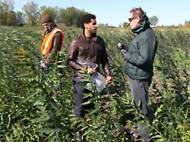Increasing phytoremediation with bacteria
 A multidisciplinary team of researchers from Canada is looking for ways to improve phytoremediation – a process where plant matter is used for decontamination. They use bacteria to stimulate faster growth capacity of certain plants and microscopic mushrooms which act as decontamination units. The researchers expect that these decontamination units will be used at various petroleum contaminated sites around the world.
A multidisciplinary team of researchers from Canada is looking for ways to improve phytoremediation – a process where plant matter is used for decontamination. They use bacteria to stimulate faster growth capacity of certain plants and microscopic mushrooms which act as decontamination units. The researchers expect that these decontamination units will be used at various petroleum contaminated sites around the world.
Mohamed Hijri, a professor of biological sciences and researcher at the University of Montreal’s Institut de recherche en biologie végétale (IRBV), and B. Franz Lang, a professor at the university’s Department of Biochemistry and the Canada Research Chair on Comparative and Evolutionary Genomics, direct the Improving Bioremediation of Polluted Soils Through Environmental Genomics project where they are trying to find the most effective ways to help the nature in its fight against contamination.
Botanist Michel Labrecque is overseeing the plant portion of the project where they chose willow as the main candidate. Willow is one of the leading species when it comes to rapid growth and premature foliation. Its stems grow even stronger once it has been cut so there is no need to plant new trees if the contamination levels are high and the process needs to be repeated next year.
“However, in contaminated soils, it isn’t the plant doing most of the work”, said Lang. “It’s the microorganisms i.e. the mushrooms and bacteria accompanying the root. There are thousands of species of microorganisms and our job is to find the best plant-mushroom-bacteria combinations.”
Although there seem to be no living organisms in polluted areas, nature tries to fight it with microorganisms. In collaboration with an oil company from the Montreal area, the researchers had access to an area where practically nothing can grow, and Hijri collected such microorganisms in order to find the ones most suitable to accelerate the process.
The process of cleaning and efficiency analysis is very time-consuming. The researchers wait for spring to plant willow cuttings at 25-centimeter (10-inch) intervals in order to create a network of roots that soak up the degrading contaminants in the timber along with the bacteria. At the end of the season, stems and leaves are burned and the leftover ash contains all of the heavy metals that were accumulated in the plant cells.
This is only the visible part of the project where soil is gradually decontaminated. In meantime, the researchers perform sampling and fieldwork, as well as DNA sequencing in order to find most effective species suitable for cleanup.
The project involves 16 researchers from the University of Montreal and McGill University, many of which are affiliated with the IRBV. The team also includes four researchers, lawyers and political scientists, specializing in the ethical, environmental, economic, legal and social aspects of genomics.
“At the end of the season, it is here that we will receive the cut plant matter from our experimental land and analyze it in great detail”, Lang said about the new luminous laboratories of the Centre sur la biodiversité. “On the second floor of the Center, research agents will work at sequencing the samples. Robots and high-precision machinery worth hundreds of thousands of dollars still need to be unpacked, which shouldn’t take long seeing as investors are expecting results in the near to midterm.”
There are several interested companies, and Lang plans to use the majority of the proceeds to help the future research at the University of Montreal and McGill University by funding disciplines connected to this project.









Good Advancement in Agriculture.
Dr.A.Jagadeesh Nellore(AP),India
E-mail: anumakonda.jagadeesh@gmail.com
Very interesting. I wonder will their results be more effective compared to mushrooms Paul Stamets found a while back.